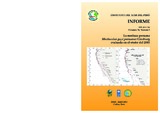Por favor, use este identificador para citar o enlazar este ítem:
https://hdl.handle.net/20.500.12958/2132Registro completo de metadatos
| Campo DC | Valor | Lengua/Idioma |
|---|---|---|
| dc.contributor.author | Aliaga Rosales, Aníbal | - |
| dc.contributor.author | Salazar Céspedes, Carlos Martín | - |
| dc.date.accessioned | 2013-06-21T15:34:37Z | - |
| dc.date.available | 2013-06-21T15:34:37Z | - |
| dc.date.issued | 2011-06 | - |
| dc.identifier.citation | Inf Inst Mar Perú 38(2), 2011 p. 193-196 | es_ES |
| dc.identifier.issn | 0378-7702 | - |
| dc.identifier.uri | https://hdl.handle.net/20.500.12958/2132 | - |
| dc.description.abstract | El crucero demersal BIC Olaya 0305-06 se realizó entre el 20 de mayo y 18 de junio 2003, para determinar la distribución y abundancia de la merluza (Merluccius gayi peruanus) y su fauna acompañante mediante el uso simultáneo del método de área barrida y el método acústico. El equipo utilizado en la evaluación acústica fue el ecosonda científico EK500 de 38 y 120 kHz de frecuencia. Las principales observaciones fueron: (1) La merluza se detectó desde 3°29’S hasta aproximadamente 7°45’S (Chicama) con predominio de áreas continuas y densas. (2) La abundancia estimada fue 120.000 t. (3) Latitudinalmente la mayor biomasa se encontró en la subárea D (6-7°S), con 67.000 t. (4) La mayor abundancia se registró a 20 mn de la costa con 54.000 t. (5) Además de la merluza, otra especie que se presentó en concentraciones interesantes fue el bereche con barbo (Larimus pacificus), cuya distribución casi continua fue desde el extremo norte del litoral hasta Paita compartiendo en muchos casos el hábitat con la merluza. | es_ES |
| dc.description.abstract | ABSTRACT: The RV Olaya 0305-06 demersal cruise was carried out from May 20th to June 18th, with the main objective to determine the distribution and abundance of hake (Merluccius gayi peruanus) and accompanying fauna by the simultaneous use of the swept area method and the acoustic method. The equipment used in the acoustic evaluation was EK500 scientific echosounder with the 38 and 120 kHz of frequency. The most important observations were: (1) The Peruvian hake was detected from 3°29’S to about 7°45’S (Chicama) with predominance of continuous and dense areas. (2) The estimated abundance was 120,000 tons. (3) Latitudinally the highest biomass was found in Subarea D (6-7°S) with 67,000 tons. (4) The highest abundance was recorded at 20 nm offshore with 54,000 tons. (5) In addition to Peruvian hake, the Pacific drum (Larimus pacificus) was another species present in important concentrations, which had almost continuous distribution from the northern tip of the coast to Paita often sharing habitat with hake. | - |
| dc.description.sponsorship | Proyecto GEF -PNUD - GEMCH | es_ES |
| dc.language.iso | spa | es_ES |
| dc.publisher | Instituto del Mar del Perú | es_ES |
| dc.relation.ispartofseries | Informe IMARPE;Vol.38 N°2 | - |
| dc.rights | info:eu-repo/semantics/openAccess | - |
| dc.rights.uri | https://creativecommons.org/licenses/by/4.0/ | - |
| dc.source | Instituto del Mar del Perú - IMARPE | - |
| dc.source.uri | Repositorio Digital IMARPE | - |
| dc.subject | Merluccius Gayi Peruanus | es_ES |
| dc.subject | Merluza | es_ES |
| dc.subject | Acústica | es_ES |
| dc.subject | Distribución | es_ES |
| dc.title | Distribución y concentración de la merluza peruana y su fauna acompañante en otoño 2003: Crucero BIC Olaya 0305-06 | es_ES |
| dc.title.alternative | Distribution and concentration of Peruvian hake and its accompanying fauna in autumn 2003: Cruise RV Olaya 0305-06 | es_ES |
| dc.type | info:eu-repo/semantics/article | es_ES |
| Aparece en las colecciones: | Informe vol. 38(2) 2011 | |
Ficheros en este ítem:
| Fichero | Descripción | Tamaño | Formato | |
|---|---|---|---|---|
| INF 38(2)-4.pdf | 1,86 MB | Adobe PDF |  Visualizar/Abrir |
Este ítem está sujeto a una licencia Creative Commons Licencia Creative Commons

